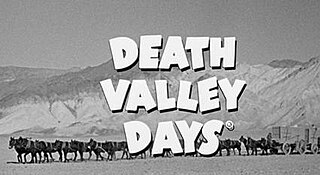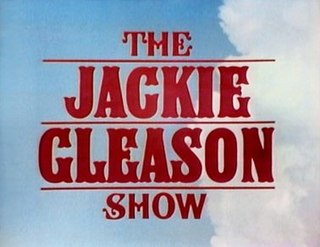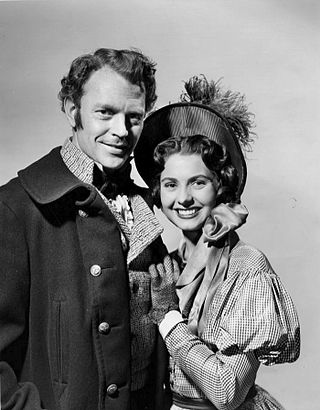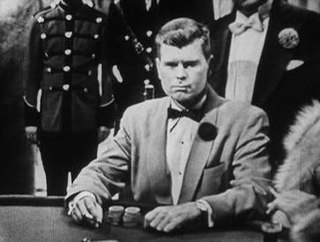
The DuMont Television Network was one of America's pioneer commercial television networks, rivaling NBC and CBS for the distinction of being first overall in the United States. It was owned by Allen B. DuMont Laboratories, a television equipment and television set manufacturer, and began operation on April 13, 1940.
The year 1955 in television involved some significant events. Below is a list of television-related events during 1955.

The Walt Disney Company has produced an anthology television series since 1954 under several titles and formats. The program's current title, The Wonderful World of Disney, was used from 1969 to 1979 and again from 1991 onward. The program moved among the Big Three television networks in its first four decades, but has aired on ABC since 1997 and Disney+ since 2020.

Death Valley Days is an American Western anthology series featuring true accounts of the American Old West, particularly the Death Valley country of southeastern California. Created in 1930 by Ruth Woodman, the program was broadcast on radio until 1945. From 1952 to 1970, it became a syndicated television series, with reruns continuing through August 1, 1975. The radio and television versions combined to make the show "one of the longest-running Western programs in broadcast history."

The Jackie Gleason Show is the name of a series of American network television shows that starred Jackie Gleason, which ran from 1952 to 1970, in various forms.

Hallmark Hall of Fame, originally called Hallmark Television Playhouse, is an anthology program on American television, sponsored by Hallmark Cards, a Kansas City–based greeting card company. It is the longest-running prime-time series in the history of television; it began airing in 1951 and is still currently in production. Since 1954, all of its productions have been broadcast in color. It was one of the first video productions to telecast in color, a rarity in the 1950s. Many television films have been shown on the program since its debut, though the program began with live telecasts of dramas and then changed to videotaped productions before finally changing to filmed ones.

Lux Radio Theatre, sometimes spelled Lux Radio Theater, a classic radio anthology series, was broadcast on the NBC Blue Network (1934–35) ; CBS Radio network (1935–54), and NBC Radio (1954–55). Initially, the series adapted Broadway plays during its first two seasons before it began adapting films. These hour-long radio programs were performed live before studio audiences. The series became the most popular dramatic anthology series on radio, broadcast for more than 20 years and continued on television as the Lux Video Theatre through most of the 1950s. The primary sponsor of the show was Unilever through its Lux Soap brand.

The United States Steel Hour is an anthology series which brought hour-long dramas to television from 1953 to 1963. The television series and the radio program that preceded it were both sponsored by the United States Steel Corporation.
Ziv Television Programs, Inc. was an American production company that specialized in productions for first-run television syndication in the 1950s.

An anthology series is a written series, radio, television, film, or video game series that presents a different story and a different set of characters in each different episode, season, segment, or short. These usually have a different cast in each episode, but several series in the past, such as Four Star Playhouse, employed a permanent troupe of character actors who would appear in a different drama each week. Some anthology series, such as Studio One, began on radio and then expanded to television.
The Philco Television Playhouse is an American television anthology series that was broadcast live on NBC from 1948 to 1955. Produced by Fred Coe, the series was sponsored by Philco. It was one of the most respected dramatic shows of the Golden Age of Television, winning a 1954 Peabody Award and receiving eight Emmy nominations between 1951 and 1956.
The following is the 1957–58 network television schedule for the four major English language commercial broadcast networks in the United States. The schedule covers primetime hours from September 1957 through March 1958. The schedule is followed by a list per network of returning series, new series, and series cancelled after the 1956–57 season.

Schlitz Playhouse of Stars is an anthology series that was telecast from 1951 until 1959 on CBS. Offering both comedies and drama, the series was sponsored by the Joseph Schlitz Brewing Company. The title was shortened to Schlitz Playhouse beginning with the fall 1957 season.

Ford Theatre, spelled Ford Theater for the original radio version and known, in full, as The Ford Television Theatre for the TV version, is a radio and television anthology series broadcast in the United States in the 1940s and 1950s. At various times the television series appeared on all three major television networks, while the radio version was broadcast on two separate networks and on two separate coasts. Ford Theatre was named for its sponsor, the Ford Motor Company, which had an earlier success with its concert music series, The Ford Sunday Evening Hour (1934–42).

"Casino Royale" is a live 1954 television adaptation of the 1953 novel of the same name by Ian Fleming. An episode of the American dramatic anthology series Climax!, the show was the first screen adaptation of a James Bond novel, and stars Barry Nelson, Peter Lorre, and Linda Christian. Though this marks the first onscreen appearance of the secret agent, Nelson's Bond is played as an American spy working for the "Combined Intelligence Agency".

A television show, TV program, or simply a TV show, is the general reference to any content produced for viewing on a television set that is broadcast via over-the-air, satellite, or cable. This includes content made by television broadcasters and content made for broadcasting by film production companies. It excludes breaking news, advertisements, or trailers that are typically placed between shows. Television shows are most often scheduled for broadcast well ahead of time and appear on electronic guides or other TV listings, but streaming services often make them available for viewing anytime. The content in a television show is produced by one of two production methodologies: live taped shows such as variety and news magazine shows shot on a television studio stage or sporting events The other production model includes animation and a variety of film productions ranging from movies to series. Shows not produced on a television studio stage are usually contracted or licensed to be made by appropriate production companies.
General Motors Theatre was a Canadian television anthology drama series of television plays, which ran on CBC Television under various titles from September 18, 1952, until January 1, 1961, and in the US on ABC from October 5 to November 2, 1958. The series mainly consisted of one-hour episodes of romance, adventure, or mystery stories, with some social realist drama plays.
The Star and the Story is an American television anthology series which aired 1955–1956 in first-run syndication. A filmed half-hour series, episodes were approximately 25 minutes long, excluding commercials.
Plymouth Playhouse, also known as ABC Album, is a half-hour American television anthology series that aired in 1953 to present "pilot program concepts."
On Stage is an American radio show also known as On Stage with Cathy and Elliott Lewis and Cathy and Elliott Lewis on Stage. It was an anthology program that aired on CBS for two seasons from 1953 to 1954.











